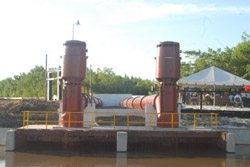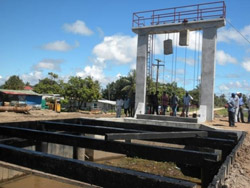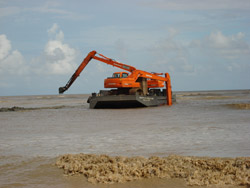RICE continues to be the star performer in the agriculture sector, recording successes every year, resulting in higher expectations and targets.
 The Ministry of Agriculture recently reported that from 50 percent of the cultivated rice land for 2013 that has been reaped, already 5.1 million bags of rice have been accumulated. In excess of 81,000 hectares or 201,000 acres of land was cultivated in this first crop.
The Ministry of Agriculture recently reported that from 50 percent of the cultivated rice land for 2013 that has been reaped, already 5.1 million bags of rice have been accumulated. In excess of 81,000 hectares or 201,000 acres of land was cultivated in this first crop.
The ministry projects that by the end of this first crop, Guyana would achieve rice production of more than 250,000 tonnes, exceeding the initial target set of 206,000 tonnes.
Officials at the Guyana Rice Development Board (GRDB) are optimistic that this first crop production would realise in excess of 260,000 tonnes.![]()
The past two years have recorded more than 400,000 tonnes of rice and Guyana is on trajectory for surpassing the 2012 record production of 422,000 tonnes.
Recently, Minister of Agriculture, Dr. Leslie Ramsammy pointed out that at the present rate of production, Guyana is on track to achieve the highest rice production ever, and will exceed the target of 450,000 set out in the Budget 2013.
This is extraordinary given the fact that such a production would be at the most, four times what was achieved in the early 90s.
But with this great success comes the new challenge faced by the farmers. Dr Ramsammy pointed to the fact that farmers are achieving yields beyond their expectation, and are challenged in finding enough trucks to transport their paddy to the mills. When they do get the trucks, they are next faced with delays in unloading the paddy because of long lines, which have led to the trucks waiting up to two days before they unload.
Dr Ramsammy pointed to the fact that farmers are achieving yields beyond their expectation, and are challenged in finding enough trucks to transport their paddy to the mills. When they do get the trucks, they are next faced with delays in unloading the paddy because of long lines, which have led to the trucks waiting up to two days before they unload.
This increased production is largely due to the success of the field school, where farmers learn new land preparation techniques and new ways of managing the crop. This new production is possible as well with the efforts of the Guyana Rice Development Board (GRDB) that have assisted farmers with better seed varieties which have led to improved yields per hectare and to more land being brought under cultivation.
Improved rice yields and more land cultivation are also the result of the National Drainage and Irrigation Authority’s (NDIA’s) interventions, which have over the years ensured secure drainage.
Drainage and irrigation is the primary foundation of any form of agriculture, and in the past 21 years interventions in this regard have been continuous, resulting in an improved system.
The Cane Grove/Mahaica area stands out as one of the country’s highest producers of rice, with farmers reaping approximately six tonnes per hectares. The overall average for the country is approximately 5.3 tonnes per hectare. The reality is that Cane Grove/Mahaica has seen continuous drainage programmes. Under the Agriculture Support Services Programme (ASSP), the NDIA also rehabilitated the Cane Grove pump at a cost of $60M, improving drainage capacity by 50 percent. The pump provides improved drainage for over 7000 acres of farmland in that location. Several canals in the area have also been put under a schedule of monthly maintenance.
The reality is that Cane Grove/Mahaica has seen continuous drainage programmes. Under the Agriculture Support Services Programme (ASSP), the NDIA also rehabilitated the Cane Grove pump at a cost of $60M, improving drainage capacity by 50 percent. The pump provides improved drainage for over 7000 acres of farmland in that location. Several canals in the area have also been put under a schedule of monthly maintenance.
In Region 5, on the right bank of the Mahaicony River, an area that can be easily affected by flood waters, the NDIA has set out to execute a huge project which targets the empoldering of 18,000 acres of land and the installation of drainage structures that would directly benefit rice cultivation.
Parallel to the Mahaicony River, the Retrieve Sluice was installed, providing increased drainage capacity.
Region 2 is the next highest producer of rice where farmers are achieving in excess of 50 bags per acre. Importantly, in this  region, five years ago, a new sluice was constructed at Golden Fleece and another at Westbury. Together, these two serve about 1300 acres of farmland.
region, five years ago, a new sluice was constructed at Golden Fleece and another at Westbury. Together, these two serve about 1300 acres of farmland.
The communities of Leguan and Wakenaam in Region 3 are benefitting from the construction of the $93.4M Waterloo sluice and the $16.37M Noitgedacht sluice respectively. The Waterloo sluice drains 2000 acres of farmland, which is half the amount of cultivated area in Leguan whilst the Noitgedacht sluice serves over 1000 acres of farmland in Wakenaam.
In Region 4, the Golden Grove/Victoria pump was rehabilitated at the cost of $61M and forms part of a $254M drainage boost to the area which also includes the rehabilitation of several structures, interventions that benefited over 5000 acres of farmland in the Golden Grove/Victoria community.
Over the last five years, the Ministry of Agriculture through the NDIA has resuscitated nine sluices and built 13, directly targeting agricultural areas.
This year the ministry has budgeted that $6.5B be spent on drainage and irrigation to continue the efficiency of this sector, and guarantee that Guyana achieves the 450,000 tonnes target set.



.jpg)








